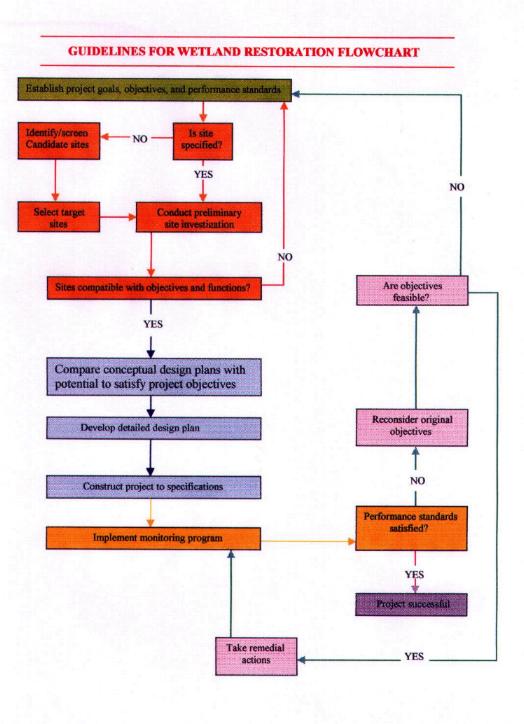|
Home
definition
functions
History
losses
alterations
Restoration Decisions: (and
theory)
design
type
site
reference sites
HGM vs. IBI
Case Studies
hydrology
vegetation
soil
landscape
State of the Science
success criteria
floristic quality
References
Created by:
Abby Rokosch
Jessen Book Siobhan Fennessy
|
Principles, Guidelines, and a Checklist for a "successful"
restoration project (from URL: www.ramsar.org)
It
is important to remember that each wetland is unique and that
these guidelines are not universal to all wetland types
PRINCIPLES
- Preserving a high quality habitat should take precedence during restoration
- Small restoration projects are beneficial but wetland restoration planning should
not ignore the surrounding landscape
- Restoration requires long-term monitoring
- Must plan for, except, and remediate
any undesirable consequences of restoration efforts (i.e. invasive
species)
GUIDELINES
(see chart below from URL: www.ramsar.org)
- Identify goals
(general statements about desired outcomes), objectives (specific
statements about desired outcome), and performance standards
(measurable attributes that can be used to determine if a project
is meeting its objectives)
- Site selection (red boxes): Site should be compatible with goals
and objectives
- Project design and construction (blue boxes): different plans
and methods should be considered based on ecological and economical principles
- Monitoring (yellow boxes): Long-term monitoring is necessary in
order to evaluate and determine the condition of the restoration project
- Performance standards are not met (pink boxes):
reconsider goals and objectives, take remedial action, document any failures
- Successful projects (purple boxes): it performance standards are achieved then
the project can be determined successful.

NATIONAL RESEARCH COUNCIL RESTORATION CHECKLIST
(reprinted from National Research Council, 1992)
Project Planning and Design
- Has the problem requiring treatment been clearly understood and defined?
- Is there a consensus on the restoration program's mission?
- Have the goals and objectives been identified?
- Has the restoration been planned with adequate scope and expertise?
- Does the restoration management design have an annual or midcourse correction point in line with adaptive management
procedures?
- Are the performance indicators--the measurable biological, physical, and chemical attributes--directly and
appropriately linked to the objectives?
- Have adequate monitoring, surveillance, management, and maintenance
programs been developed along with the project, so that monitoring
costs and operational details are anticipated and monitoring
results will be available to serve as input in improving restoration
techniques used as the project matures?
- Has an appropriate reference system (or systems) been selected from which to extract target values of performance
indicators for comparison in conducting the project evaluations?
- Have sufficient baseline data been collected over a suitable
period of time on the project ecosystem to facilitate before-and-after
treatment comparisons?
- Have critical project procedures been tested on a small experimental
scale in part of the project area to minimize the risks of failure?
- Has the project been designed to make the restored ecosystem as self-sustaining as possible to minimize maintenance
requirements?
- Has thought been given to how long monitoring will have to be continued before the project can be declared
effective?
- Have risk and uncertainty been adequately considered in project planning?
During Restoration
- Based on the monitoring results, are the anticipated intermediate objectives being achieved? If not, are appropriate
steps being taken to correct the problem(s)?
- Do the objective or performance indicators need to be modified? If so, what changes may be required in the
monitoring program?
- Is the monitoring program adequate?
Post-Restoration
- To what extent were project goals and objectives achieved?
- How similar in structure and function is the restored ecosystem to the target ecosystem?
- To what extent is the restored ecosystem self-sustaining,
and what are the maintenance requirements?
- If all natural ecosystem functions were not restored, have
critical ecosystem functions been restored?
- If all natural components of the ecosystem were not restored, have critical components been restored?
- How long did the project take?
- What lessons have been learned from this effort?
- Have those lessons been shared with interested parties to
maximize the potential for technology transfer?
- What was the final cost, in net present value terms, of the restoration project?
- What were the ecological, economic, and social benefits realized by the project?
- How cost-effective was the project?
- Would another approach to restoration have produced desirable results at lower cost?
For a list of research questions, click here!
|
